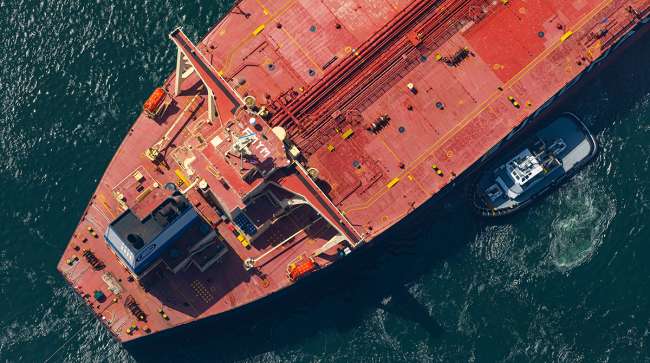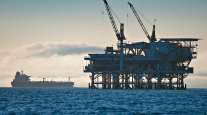Bloomberg News
Oil Tanker Rates Soar on Biden Sanctions Against Russia

[Stay on top of transportation news: Get TTNews in your inbox.]
Oil tanker rates jumped Jan. 13 as the Biden administration’s sanctions on Russia’s petroleum trade threaten to cut the supply of ships while forcing traders to seek alternative sources of crude.
On Jan. 10, 10 days before Donald Trump takes over, the outgoing president sanctioned about 160 Russian oil tankers. It means about a tenth of the current crude-carrying fleet is under U.S. measures. Benchmark tanker rates jumped 39%, the most since August, tracing a rally in shares of the world’s largest pure-play owners of the ships.
The hike is just one example of how the sanctions — the most aggressive by any western power since the war in Ukraine began — are threatening to disrupt Russia’s petroleum supply chain. The vast majority of tankers sanctioned by the U.S. in previous rounds haven’t loaded any cargoes since then, and the sweeping scale of the latest move has driven a more than $4 a barrel increase in Brent crude futures.
Even before the sanctions, refiners in India and China had been hurriedly seeking barrels of Middle Eastern oil on worries about potentially lost supplies from Russia and also Iran. On Jan. 13, a senior official in India said the country plans to reject oil tankers sanctioned by the U.S., highlighting another potential pull on the pool of unsanctioned vessels.
“There is a path for markets to strengthen materially on the back of the new vessel sanctions,” Anoop Singh, global head of shipping research at Oil Brokerage wrote. “A necessary condition for freight rates to surge would be the forced idling of the sanctioned fleet. Precedent supports that outcome.”
The widespread blacklisting came on the back of repeated targeting of ships hauling Iranian oil, further pressuring some tankers’ ability to keep trading and effectively hitting fleet supply.
The risk of disruption to the freight market has been made more acute by a lack of new ships being delivered to the market.
With the so-called shadow fleet keeping vessels employed for longer, the “compliant” crude tanker fleet hasn’t expanded since 2022, according to the boss of Frontline Management AS.
This is what makes the recent tightening from #US & #China on #sanctioned #tankers exciting. In broad terms, the compliant VLCC, Suez and Afra fleets (< 20Y) stopped growing in Sep22…. #OOTT $FRO pic.twitter.com/xlPz9AAewW — Lars H. Barstad (@lh_barstad) January 11, 2025
It’s against that lack of growth that the oil tanker industry has been looking at the impact of previous tanker sanctions. Ship-tracking data compiled by Bloomberg show 33 out of 39 tankers designated haven’t moved cargoes since falling under U.S. measures.
Shares of Frontline surged more than 10% on Jan. 10 and continued to rally on Jan. 13. Other listed tanker businesses including DHT Holdings Inc., International Seaways Inc. and Okeanis Eco Tankers also followed up significant gains on Jan. 10 with a further rally on Jan. 13.
Shorthaul oil deliveries from Russia’s eastern ports to China could have to be switched with flows from the Middle East, which would require much longer sailing distances, Braemar Plc analysts including Henry Curra and Yiling Yi wrote in a note.
“OFAC sanctions are the only ones that genuinely restrict the employment of the vessel,” they said. “These sanctions will bite.”
Despite bullish rhetoric, there’s yet to be the kind of spike that followed when the U.S. sanctioned China’s largest shipping company in 2019, propelling benchmark earnings to $300,000 a day. On Jan. 13, they were still far below that level at $37,822, according to the Baltic Exchange.
Still, it remains unclear how Trump will approach the measures when he takes office next week, and it’s likely that Russia will try to find ways to work around any restrictions.
If India seeks replacement barrels, it’s possible they’ll be from closer sellers than Russia, also limiting a boost to rates. A loss of cargoes from two sanctioned exporters, were that to materialize, could also be bearish.
Want more news? Listen to today's daily briefing above or go here for more info
But in recent months, a significant chunk of the global shipping fleet has been sanctioned, heightening the risk to trade.
Clarksons Securities AS estimates that about one in 10 crude-carrying tankers are now under U.S. sanctions. Earnings could top $100,000 a day this year, analysts including Frode Morkedal said, a level they’ve not hit since late 2022.
“For tankers, I think the most important part is the changing narrative on the dark trade,” said Jon Nikolai Skaaland, an analyst at SEB AB. “The U.S. seems eager to punish Russia and Iran.”




